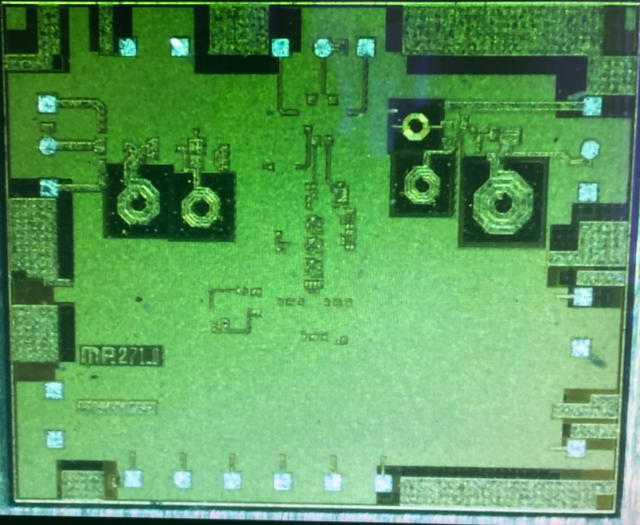Specialists of the SevSU Micro- and Nanoelectronics Engineering Center have developed a complex-functional monolithic integrated circuit (SF MIS) for use in domestic microwave receivers and transmitters with active phased array antennas
The chip is designed to control the amplitude and phase of the signal (Core Chip) in the frequency range of 4-6 GHz based on silicon-germanium (SiGe) BiCMOP TSMC 3P6M+ process technology with a design norm of 180 nm.
Due to the use of SiGe BiCMOP, microwave MIS production technologies are more advanced than gallium arsenide technologies used for AFAR receiving and transmitting modules, which makes it possible to obtain a significantly higher percentage of usable microcircuits. The high integration of the microchip elements in silicon makes it possible to more effectively solve the problem of reducing energy consumption and cooling of MIS, as well as aggregating analog microwave and digital MIS units, which reduces the crystal area. The linear dimensions of the crystal topology of the developed microcircuit were 2.5×2.4 mm (crystal area — 6 mm2), which is significantly less than the crystal area of SF MIS analogues manufactured on the basis of gallium arsenide technologies. All this affects the final cost of the AFAR system in the direction of its reduction, which will make it possible to bring such systems to the mass market and expand the range of their applications in the civilian sphere.
The key features of the developed microcircuit include a "Common leg" structure and a temperature correction circuit. The developed MIS contains controllable receive/transmit switches, a vector phase shifter, an attenuator, and amplification cascades. The interface converter (serial to parallel) included in the module for controlling the attenuator, phase shifter and switches greatly simplifies interaction with an external microcontroller. One of the important advantages of the developed microcircuit is the presence of a signal temperature correction unit in its composition. This makes it possible to reduce, in comparison with analogues, the values of errors in determining the phase and amplitude of microwave signals, which directly affect the accuracy of the AFAR radiation pattern formation. At the same time, the characteristics of the transceiver modules, which are comparable to their analogues and acceptable for civil and special applications, are preserved.
The SevSU Engineering Center, with the help of an industrial partner, has already produced an experimental batch of microwave MIS crystals. The conducted probe measurements generally confirm the parameters of the microcircuit, the values of which made it possible to achieve the best characteristics among this class of microcircuits.
Currently, NIIME JSC specialists are implementing SiGe BiCMOP 180 nm technology on the basis of Micron JSC, who are interested in developing SF MIS Engineering Center for Micro- and Nanoelectronics Products at SevGU. JSC NIIME plans to create complex-functional X-band MIS for satellite communication systems in cooperation with Sevastopol State University.
Microwave chips are an essential element in radar systems, communications and telecommunications systems for dual and civilian purposes. In the last decade, there has been a trend towards the use of AFAR in the segment of specialty and consumer electronics. Thus, the development of L-, S- and C-band wireless technologies (GSM, Wi-Fi, WiMAX, LTE, advanced 5th generation (5G) mobile communication networks, satellite navigation and communications, commercial radars) has led to the need to create inexpensive, and at the same time high-quality, compact systems with electronically controlled antenna patterns. One of the limiting factors in the widespread use of AFAR is their high cost, due to the high cost of transceiver modules currently being built by Russian enterprises primarily based on gallium arsenide (GaAs) microwave monolithic integrated circuits.
Information source: Press Office of the Engineering and Innovation in Russia Project at the Industrial Project Management Center


